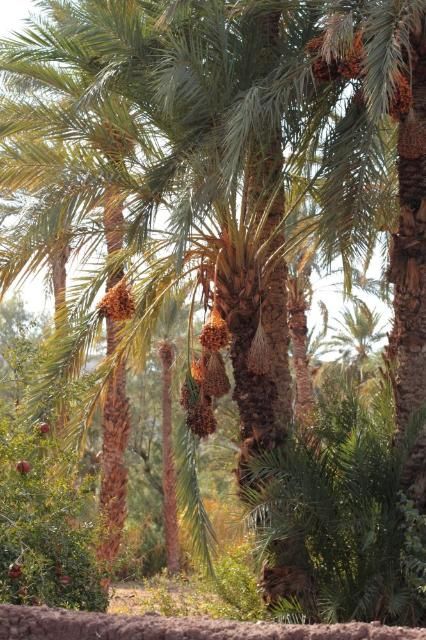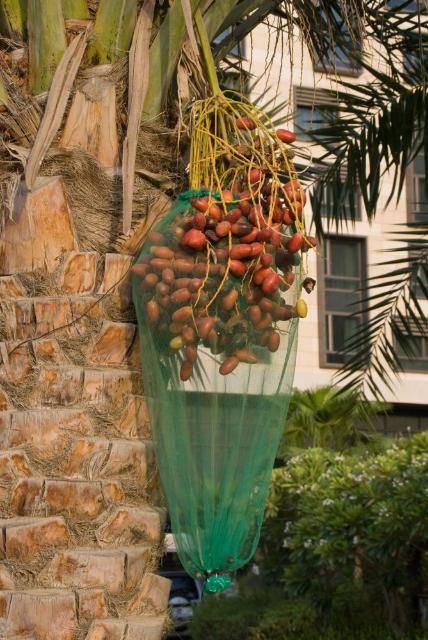Family
Arecaceae, palm family.
Genus
Phoenix is the Latin term for the Greek word that means "date palm."
Species
The species name dactylifera means "finger-bearing" and refers to the fruit clusters produced by this palm. Dactylifera is a combination of the Greek word dactylus, or "finger," and the Latin word ferous, or "bearing."
Common Name
Date Palm
The common name comes from the fact that the palm bears fruit called dates, which are not only edible, but also tasty.
Description
While the native range of this palm is uncertain, it is thought to be indigenous to either North Africa or the Middle East. It is also present in Turkey, Pakistan, and Northwest India, but is thought to have been introduced to these areas long ago through human transport. Although date palm prefers dry climates, it occurs along rivers and streams and in areas of the desert that have underground water sources. In America, this tree grows well in regions where there is low humidity, although it is found in humid areas like Florida, and where the temperatures do not fall below 15°F. Date palm is slow growing and requires full sun for optimal growth; it can reach heights up to 80 feet. The pinnately compound blue-green to gray-green leaves or fronds can grow to 20 feet in length; leaflets are 1 to 2 feet long and form a "V" shape down the rachis. The petiole (stem that attaches the leaf to the trunk) is considered "false" because it contains 3- to 4-inch thorns that are actually modified leaflets. When young, the trunk bears boots (remnant petioles that were attached to the trunk); when mature, the boots wear and become knobby but still show a characteristic spiraling leaf arrangement. Orange inflorescences can reach lengths of 4 feet, are heavily branched, bear small white blossoms, and grow among the leaves. The oblong edible fruits are 1 to 3 inches long and occur in orange or red masses when mature.

Credit: Multivac42, CC BY-NC-ND 2.0

Credit: Sericea, CC BY-NC 2.0
Allergen
Each individual tree is either a male or a female (as is true for all species within this genus). Male trees are extremely allergenic because their pollen is air-borne, whereas the female palms cause minimal to no allergies.
Applications
Commercial/Practical
People in the Middle East have used the date palm as a main food source for at least 1000 years. It is only in the last several hundred years that it became a global commodity. Today, cultivation of date palm has spread into many other parts of the world including the United States. Currently, there are hundreds of varieties of the date palm, with noticeable differences in fruit characteristics. Only two varieties produce fruit in areas with humidity similar to that of the Gulf Coast region of the United States.
Horticultural
Date palm makes an attractive landscape specimen with its blue-green leaves, textured trunk, and bright orange inflorescences. It requires neutral to acidic soils that are well drained, and it should be located where it can receive direct sunlight. The date palm is commonly used as a street tree because it is able to thrive even when there is limited space for root growth; however, some find the fallen fruits to be messy and undesirable along sidewalks. Although its crown is wide, it is not very dense, and therefore the date palm does not function well as a shade tree. Fruit production requires that both female and male trees be present in the same area. Some minor upkeep may also be required, and many homeowners trim the lower leaves to discourage a fungus that commonly develops in warmer climates. This species is susceptible to lethal yellowing disease (https://edis.ifas.ufl.edu/pp146), so it is best to avoid planting the date palm where the disease is present.
References
Borror, D. J. 1988. Dictionary of root words and combining forms (2nd ed.). Mountain View, CA: Mayfield Publishing Company.
Coombes, A. 1994. Dictionary of plant names: Botanical names and their common name equivalents. Portland, OR: Timber Press.
Floridata.com. 2004. Phoenix dactylifera, Retrieved from http://www.floridata.com/ref/p/phoe_dac.cfm
Gilman, E. F. 1997. Trees for urban and suburban landscapes. Albany, NY: Delmar Publishers.
Harrison, N. A. and M. L. Elliot. 2009. Lethal yellowing (LY) of palm (PP146). Gainesville, FL: UF-IFAS Florida Cooperative Extension Service. Retrieved from https://edis.ifas.ufl.edu/pp146
Meerow, A. W. 2004. Betrock's guide to landscape palms (9th ed.). Hollywood, FL: Betrock Information Systems.
Ogren, T. L. 2000. Allergy-free gardening: The revolutionary guide to healthy landscaping. Berkeley, CA: Ten Speed Press.
Riffle, R. L. and P. Craft. 2003. An encyclopedia of cultivated palms. Portland, OR: Timber Press, Inc.